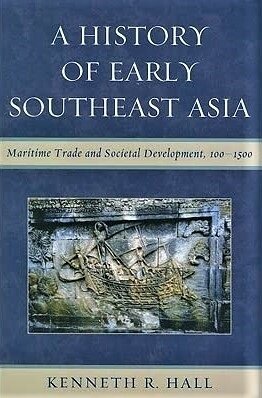A History of Early South East Asia
by Kenneth R. Hall
A major study on regional and global trade historic phases, their impact on development of polities and kingdoms around 1th-16th centuries Southeast asia.

Type: paperback
Publisher: Rowman & Littlefield Publishers, Lanham MD, USA
Published: 2011
Author: Kenneth R. Hall
Pages: 383
ISBN: 9780742567610
Language : English
This ambitious -- and quite luminous -- regional vision of trade and diplomatic relations, wars and alliances between the multiple kingdoms, tribal fiefdoms, maritime polities and federations or empires in-the-making during the first sixteen centuries of the first millenium is a stimulating synthesis of epigraphic, archaeological and scriptural sources for all contemporary researchers.
With China and India always in the background, the author depicts how Southeast Asia, the 'Golden Island or Peninsula' (Yavadvipa or Suvarnadvipa in Indian traditions), the 'spice capital of the world', attracted from the earliest times Roman, Greek, Parthian (Persian), Jewish, Arab, Chinese, Indian and Malayo-Austronesian merchants while resolving its inner tensions and conflicts, opting for various religious trends and preserving (or sometimes suppressing) its multiple ethno-cultures, local beliefs and traditions.
Amongst this rich corpus of sociological, commercial and religious history, we will note:
- One of the clearest exposés on the rise and marginalization of Funan, when the maritime routes linking the Western world and India to China started to divert southwards, attracted by entities such as the Srivajaya kingdom and the Javanese commercial ports-of-call.
The Chinese accounts of the legends related to the establishment of Funan (around 240 CE) are masterfully summarized: 'A local princess (whom the Chinese called Linyeh) led a raid on a passing merchant ship of unspecified nationality. The ship's passengers and crew managed to fend off the raiding party and made a landing. One of them was Kaundinya, a man from a country "beyond the seas"(India). Linyeh married him and he drank of the local waters, suggesting an oath of loyalty. As Funan was a matrilineal society, Kaundinya thereby became part of the local lineage, and as its heir he became the first Funan monarch.'
Quite interestingly, the kingdom that finally supplanted Funan as stopover on South China Sea trade routes, on the Vietnamese coast, was called Linyi.
- Óc Eo (អូរកែវ, Or Kaev (Crystal Stream) in Khmer), nowadays in the Vietnamese province of An Giang yet intrinsic part of 'Kampuchea Krom' Lower Cambodia), was for six centuries the main maritime facade for inland principalties that would later coalesce into the Khmer Empire, the Champa constellation and 'Dai Viet', the Land of the Vietnamese close to the Chinese border.
- The elevated role and position of women in Southeast Asian societies, which resisted the Chinese strictly patriarcal lineage and family organization.
The author gives several exemples, in particular Nyai Gede Pinateh (or Pinatih), syahbandar (harbormaster) of the Sumatra port of Gresik around 1500. This strong woman, still revered nowadays for her effort to propagate the Islam faith, was of Chinese and possibly Cambodian origin.
- How Khmer rulers gradually shifted from Indrapura-Amaravati (nowadays Hoi An in Vietnam) to Vijaya port (nowadays Sri Banoy) for their commercial and maritime exchanges across the South China sea.
- The complex balance of power between Angkorian rulers and Champa successive rulers, and how internal dissensions affected regional policies. For instance, the author stresses the many times when Angkor kings related to Champa military forces not as enemies but as allies.
- How the 'temple-based economy' of the Khmer Empire, its preference for barter relations and disdain for monetary tools impacted its geographical expansion, and left it isolated from the new trade routes,while Javanese and Malaysian rulers were opting for more and more integration to the international trade system (a whole section of the book, Chap 6, pp 159-209, is devoted to the Khmer Empire).
Photo: Vishnu statue found at Óc Eo, site discovered by archaeologist Louis Malleret in 1940 (Ho Chi Minh Museum)

Tags: trade, maritime routes, Islamization, Indianization, China, Vietnam, Burma, Siam, Java, Srivijaya, commerce, women, barter
About the Author

Kenneth R. Hall
A professor of history at Ball State University, Kenneth R. Hall is a specialist in pre-1500 South and Southeast Asian history and culture, comparative urbanization and wider Indian Ocean maritime networking.
Among his numerous publications, these are particulary interesting for Angkorean researchers and lovers: A History of Early Southeast Asia: Maritime Trade and Societal Development c. 100-1500 (2011); “Champa Ports-of-Trade Networking on the Coastline c. 300-1500 CE” (Bangkok); “Regional Identities, Maritime Networking and Islamic Conversions in Fifteenth-Century Java“ (London);“Revisionist Study of Mainland South-East Asia’s Maritime Connections, c.100-1500” (Delhi); “South Asia: 8th Century India Transitions” (Leeds); “Contested Histories of Ming Agency in the Java Sea, Straits of Melaka, and Bay of Bengal Region” (New York); “Knowledge Transfers in 14th and 15th Century Java” (Singapore), and “Ayutthaya’s Seventeenth-Century Deerskin Trade in the Extended Eastern Indian Ocean and South China Sea” (New York/Leeds).
He is on the advisory board of The Journal of the Economic and Social History of the Orient, and was a Fulbright Senior Scholar/Professor of comparative religion at Gadjah Mada University in Indonesia (2003–2004) and Southeast Asian studies at the Royal University of Phnom Penh (2012).
